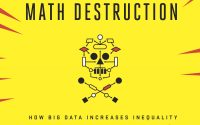Everybody Will Be Hip and Rich: Neoliberal Discourse in Silicon Valley
In December of 2015, Facebook founder and CEO Mark Zuckerberg and his wife Priscilla Chan posted “A Letter to Our Daughter” in which they pledged the majority of their wealth to philanthropic causes. Ostensibly a discussion of rising global concerns, the letter frames technology as a singularly ameliorative force. As they write, “We must build technology to make change. Many institutions invest money in these challenges, but most progress comes from productivity gains through innovation” (emphasis in original). In this passage, Zuckerberg and Chan’s ascription of agency frames technology—abstracted from governance, labor, or human intervention—as a wellspring of global progress. In structuring the world in such techno-financial terms and positing technology as a uniquely progressive agent, the letter exhibits several of the rhetorical features of the emergent, neoliberal1 shibboleth of Silicon Valley that I term “tech talk.”
In what follows, I develop this concept to distinguish the discourse of Silicon Valley entrepreneurship from the rhetoric of financial deregulation. While the two hold an intimate association, tech talk exhibits several discrete features that distinguish it from orthodox neoliberalism. These features—a techno-utopian style,2 the aestheticization of new technology, and the valorization of perpetual revolution—represent a shift away from the managerial and risk-oriented realism of prevailing free market discourse and toward an idealistic position that offers an unproblematic view of the technological future and works to hasten its arrival.3 As I argue, tech talk is a permutation of free market rhetoric that more efficiently occludes the antagonisms inherent in global capitalism and more effectively courts the contemporary consumer.
Conventional Neoliberalism
In 1982, Deirdre McCloskey’s The Rhetoric of Economics inaugurated the discipline’s critique of economics, framing it as both linguistically driven and inherently persuasive. Since its publication, disciplinary attention to economic rhetoric has largely split along political lines. McCloskey, by way of rhetoric, has continued to enrich and extend economics and to defend the values of intellectual and economic liberalism. As she argues in “The Rhetoric of Liberty,” rhetoric is implicated in the discourse of freedom: “Any defense of liberty will make use of rhetoric . . . . [T]he free market in ideas is a rhetorical idea at the heart of free societies” (9).
Other scholars have been comparatively more critical of the implicit values within economic discourse, particularly regarding laissez-faire economics (Asen, Invoking the Invisible Hand, “‘To Exist, You Need an Ideology’”; Aune; Cloud; Nguyen; Pauliny; Riedner; Wingard). Critiquing the field’s allowances for the free market, Cloud argues that rhetoricians “need to attend to the economic contexts, motivations, and constraints of the discourses we study if we are to align ourselves . . . on the side of democracy and economic justice” (356). In one of the discipline’s most critical investigations of free market discourse, James Arnt Aune observes that that libertarianism employs an “antirhetorical rhetoric” (41) that manufactures the appearance of neutrality. For Aune, this style “works by radically separating power and textuality, constructing the political realm as a state of nature,” (41) and generally presenting economic discourse as beyond the realm of argumentation. Cumulatively, Aune conceives of free market rhetoric as a discourse of self-promotion that attempts to pose deregulation as a comprehensive corrective. As he argues, free market rhetoric presumes that “social problems can be solved by creating a market” (Aune 8; emphasis in original).
Robert Asen’s analysis of “market talk” (Invoking the Invisible Hand, “‘To Exist, You Need an Ideology’”) builds upon Aune’s work, offering arguably the field’s most systematic critique of free market rhetoric to date. For Asen, market talk is the ideological “voice of the market” (“‘To Exist You Need an Ideology’” 233), a discourse that “embraces markets as essential bearers of human liberty” (233). Asen, like Brown, understands market talk as fundamentally antagonistic to democracy in spite of its putative liberatory agenda (Invoking the Invisible Hand 247). As he argues, market talk “privileges norms of self-enrichment over potentially competing norms of justice in prescribing the rights and norms of citizenship” (Asen 12). More acutely, Asen regards the discourse as mistrustful of transparently rhetorical language, “treat[ing] language as a veil over nature” (14). With Aune, Asen suggests that free market discourse operates through constructions of reality and necessity that posit deregulation as obligatory.
Recently, Rachel Riedner has addressed the affective dimensions of neoliberal discourses, arguing that they “invoke and promise economic and political empowerment, political inclusion, and freedom from violence and they highly regard independence and personal self-responsibility” (xii). Like Asen, Riedner argues that these discourses frame themselves as accessory to liberation while surreptitiously consolidating financial power. Neoliberal rhetorics, she claims, promise the goods of “recognition, freedom, and incorporation” (xii) through free market participation, “orienting our affective energies toward . . . [the] value of ‘freedom’ of global markets” (xii).
While countless contemporary figures employ this discourse, journalist Thomas Friedman offers a paradigmatic example of market talk in this recent ABC News interview with George Stephanopoulos.
In Friedman’s characterization, the accelerations of capitalism, climate change, and technology pose enormous risk4 to modern society. In offering a solution to these shifts, Friedman “purports to reveal the true nature of things” (Asen, Invoking the Invisible Hand 14) by presenting as obvious the need for strategic, market-based solutions like the elimination of all corporate tax. In positing free market solutions as a way to “build an eye that moves with the storm [and] draws energy from it,” Friedman exemplifies Aune’s characterization of free market rhetoric by ascribing to the view that “social problems can be solved by creating a market” (Aune 8; emphasis in original). This position also illustrates Riedner’s charge that neoliberal rhetorics direct us toward the “‘freedom’ of global markets” (xii).
As the technology industry is intimately involved in the processes of economic globalization, it is tempting to view tech talk as merely the latest iteration of market talk. It is the case that, like market talk, tech talk critiques government regulation as a limitation on technological potential. In a 2009 essay for Cato Unbound, venture capitalist and PayPal cofounder Peter Thiel notes, “I no longer believe that politics encompasses all possible futures of our world. . . . [T]he great task for libertarians is to find an escape from politics in all its forms. . . . I have focused my efforts on new technologies that may create a new space for freedom” (emphasis added). While posing technology as the engine of liberation, Thiel nevertheless follows the values of market talk by characterizing governments as a threat to technological and individual freedom; however, despite the convergence of the two discourses, tech talk is uniquely concerned with promoting technology itself as an emancipatory force capable of addressing a host of global problems.
Unlike Friedman, whose ungainly hurricane analogy posits economic, climate, and technological accelerations as challenges to be withstood, tech industry advocates tend to frame technological upheaval in nearly univocally positive terms. Twitter cofounder Jack Dorsey’s characterization of technological disruption (he prefers the term “revolution”) as desirable in a 2013 talk at Stanford School of Business, seen below, represents a remarkably divergent outlook.
In this representative case, Dorsey frames technological change as progressive, suggesting that technological advancement should be considered analogously to the July Revolution of 1830, the Tiananmen Square protests of 1989, and the Indian Independence Movement. Rather than posing radical change as risk to be weathered or negotiated, Dorsey evokes change as a salutary force, something “that can move the entire world.”
Bleeding Edge Neoliberalism
As I have suggested, tech talk corresponds with market talk insofar as it voices a set of axiomatic values promoting an improved global society and greater consumer agency; however, while market talk strives merely to capitalize on technology, which it understands as both opportunity and risk, tech talk’s interest lies in securing technology’s ascendancy. Additionally, while tech talk frequently tracks market talk’s posture of “describ[ing] the world as it truly is” (Asen, Invoking the Invisible Hand, “‘To Exist You Need an Ideology’” 233), its disingenuously anti-rhetorical posture tends toward pronouncements of future gain rather than to sober discussions of risk mitigation.
The first crucial difference between the two discourses concerns tech talk’s adoption of a techno-utopian style promoting technology as a panacea for social, political, environmental, and economic problems. Without regard for the dangers posed either by deregulation or the growth of technology itself, tech talk presents technology as entirely free of risk. Uber cofounder Travis Kalanick’s 2016 TED Talk offers an example of such an argument.
In the clip, Kalanick makes the claim that deregulating technology will result in vast social and civic improvements. By discussing how the Jitney, an early twentieth-century means of ridesharing, was regulated out of existence and how the US government now caps the maximum cost of rides, Kalanick frames regulation as the enemy of innovation. Noting that mass transit has failed to meet the growing needs of citizens, Kalanick casts the technology industry, and Uber specifically, as capable of addressing them. Through deregulation, he claims, Uber will “cut congestion, pollution, and [alleviate] parking.” Entirely omitting such issues as labor or inequality, Kalanick maintains that with technological autonomy, “we can reclaim our cities.”
Further utopianism is evident in tech talk’s aestheticization of new technology. In its depiction of technologically mediated lifestyles, particularly its implicit assertion of technology’s immediate role in the elevation of consumers’ living standards, the industry romanticizes technology as individually enriching, free of disadvantages, and visually appealing.5 Perhaps the most illustrative area of this aestheticizaton lies in the emerging area of the so-called “internet of things,” the movement to create networks of smart devices. A commercial from multinational technology company Lenovo demonstrates such a vision of technology enhancing and refining the lives of consumers.
In the commercial, the connected environment facilitates a happy home life. The minutiae of the daily routine, food preparation, the manipulation of devices, and the negotiation of problems are all undertaken by smart devices. The consumer, liberated from domestic tasks, is shown passing through modern, curated spaces placidly sustained by the succor of connected objects. In the ad, the typical framing of neoliberalism that fronts market intervention as a defense from uncertainty is absent, replaced by a depiction of a serene and beautified lifestyle.
A third distinguishing feature of tech talk’s rhetorical style is its valorization of revolution. Tech talk broadly celebrates transformation as an organizing paradigm of technology’s role in the contemporary world; however, unlike the rhetoric of political revolution that focuses on a single revolutionary event, tech talk celebrates perpetual innovation. Media theorist Ian Bogost observes such esteem for epochal change as embedded in Apple’s corporate culture: “‘Change’ has become an idea so synonymous with Apple that it must be perpetuated through its branding and marketing. . . . Change is no longer political nor social nor industrial. . . . Instead, it’s commercial and aesthetic” (30). For Bogost, Apple’s claims to revolution are about optics rather than legitimate transformation. As he notes, “The most impactful and lasting revolutions don’t fetishize revolution itself but establish a new regime that lasts over time” (33). With Bogost, I suggest that tech talk establishes a cult of innovation to control the narrative of its ascendancy and to secure profitability, periodically releasing goods whose ownership it constructs as obligatory.
One of the most striking examples of this, and indeed a canonical example of tech talk, is Steve Jobs’s introduction of the iPhone in 2007.
In the talk, Jobs recounts a history of Apple as a history of “revolutionary” products. Noting that the Macintosh “changed the whole computer industry” and that the iPod “changed the whole music industry,” he likewise presents the iPhone as epochal. Jobs’s chronology of Apple’s products frames the company, and indeed the technology industry writ large, as a singularly agentive force in global affairs; however, Jobs’s notion of revolution, evoked through his discussion of three revolutionary products, is a revolution in need of frequent revitalization. Dependent upon planned obsolescence, Apple consistently (re)frames the ownership of revolutionary devices as necessary for participation in the emergent techno-social paradigm. Unlike market talk, whose defense of mass deregulation often remains abstracted from the practices of consumption, tech talk speaks directly to consumers and actively courts their participation in securing technological hegemony.
To close, it has been my purpose here to analyze the emerging rhetoric of the technology industry in relation to the discourse of the free market. As I have argued, while the two share several features, tech talk is a unique discourse that seeks the ascendency and autonomy of new technology. More effectively than standard neoliberal discourse’s dialectic of risk and stability, tech talk appears to have succeeded in strengthening the deregulatory appeals of market talk by activating consumers’ desires for wealth, comfort, and social distinction, effectively rendering neoliberalism both more proximate and more seductive to the average person. Insofar as we are able, rhetoricians should actively attend to the flourishing of this discourse and strive to incorporate analysis of its liberatory claims into our work in digital rhetoric. While, as a field, we are deeply attuned to the technological developments of Silicon Valley, increasingly incorporating them into both our teaching and scholarship, much more of our attention could be paid to the rhetorical dynamics of the industry itself and how these are operative in shaping public attitudes toward technology, consumerism, and neoliberalism.
Endnotes
- As Wendy Brown argues, “[Neoliberalism] assaults the principles, practices, cultures, subjects, and institutions of democracy understood as rule by the people. . . . [A]ll spheres of existence are measured in economic terms and metrics” (9-10). It should be acknowledged that allegations of Silicon Valley’s neoliberalism are long-standing. In 1995, Richard Barbrook and Andy Cameron outlined the “Californian ideology,” an outlook that “promiscuously combines the free-wheeling spirit of the hippies and the entrepreneurial zeal of the yuppies, . . . a profound faith in the emancipatory potential of the new information technologies. In the digital utopia, everybody will be both hip and rich” (4). return
- Marlana Portolano defines utopian rhetoric as “any kind of symbolic expression of hope for a better world, whether in a concrete future or in fictional or spiritual realms, and no matter if that expression is considered in a positive or negative light” (114). return
- To be sure, some tech CEOs have expressed concern over the future of AI. See Hackett. return
- Scholars have become increasingly interested in neoliberalism’s use of risk (Beck; Goodnight and Green; Hoskins and Tulloch). As G. Thomas Goodnight and Sandy Green argue, “risk culture” (115) is the firmament of the boom and bust paradigm of late capitalism. For Ulrich Beck, risk provides capital with the grounds to “merge . . . with the state in order to open up new sources of legitimacy in the guise of the neoliberal state” (65; emphasis in original). return
- Much has been written on the aesthetics of new technology. See von Borries et al., Kane, Manovitch, and Zufi. return
Works Cited
- Aune, James Arnt. Selling the Free Market: The Rhetoric of Economic Correctness. Guilford Press, 2002.
- Asen, Robert. Invoking the Invisible Hand: Social Security and the Privatization Debates. Michigan State UP, 2009.
- ———. “‘To Exist, You Need an Ideology’: Alan Greenspan on Markets, Crisis, and Democracy.” Making the Case: Advocacy and Judgment in Public Argument, edited by Kathryn Olson, Kirt Wilson, Michael Pfau, and Ben Ponder, Michigan State UP, 2009, pp. 231-56.
- Barbrook, Richard, and Andy Cameron.“The Californian Ideology.” Science as Culture, vol. 6, no. 1, 1996, pp. 44-72.
- Beck, Ulrich. World at Risk. Translated by Ciaran Cronin, Polity Press, 2009.
- von Borries, Friedrich, Ina Grätz, Harald Klinke, Bernd Polster, Henry Urbach, Thomas Wagner, and Peter Zec. Apple Design. Hatje Cantz, 2011.
- Brown, Wendy. Undoing the Demos: Neoliberalism’s Stealth Revolution. Zone Books, 2015.
- Bogost, Ian. The Geek’s Chihuahua: Living with Apple. Forerunner: Ideas First, 2015.
- Cloud, Dana. “Rhetoric and Economics: Or, How Rhetoricians Can Get a Little Class.” Quarterly Journal of Speech, vol. 88, no. 3, 2009, pp. 342-58.
- Colombini, Crystal. “‘Market Talk’ and Talking Back: Recent Studies from Communication and Rhetorical Studies.” Journal of Cultural Economy, vol. 8, no. 1, 2014, pp. 115-22.
- Goodnight, G. Thomas, and Sandy Green. “Rhetoric, Risk, and Markets: The Dot-Com Bubble.” Quarterly Journal of Speech, vol. 96, no. 2, pp. 115-40.
- Hackett, Robert. “Watch Elon Musk Diverge His Biggest Fear About Artificial Intelligence.” Fortune, 17 Aug. 2016, www.fortune.com/2016/08/17/elon-musk-ai-fear-werner-herzog./ Accessed 3 Dec. 2016.
- Hoskins, Andrew, and John Tulloch. Risk and Hyperconnectivity: Media and Memories of Neoliberalism. Oxford UP, 2016.
- “Jack Dorsey: The Future Has Already Arrived.” YouTube, uploaded by Stanford Graduate School of Business, 13 May, 2013, youtu.be/AckvbL5Tfic?t=1s.
- Kalanick, Travis. “Uber’s Plan to Get More People into Fewer Cars.” TED, Feb. 2016, www.ted.com/talks/travis_kalanick_uber_s_plan_to_get_more_people_into_fewer_cars.
- Kane, Carolyn L. Chromatic Algorithms: Synthetic Color, Computer Art, and Aesthetics After Code. U of Chicago P, 2014.
- “Lenovo Tech World–Internet of Things.” YouTube, uploaded by Lenovo, 27 May, 2015, youtu.be/lsiHUfIpNGY.
- Manovich, Lev. Software Takes Command. Bloomsbury Academic, 2013.
- McCloskey, Deirdre. The Rhetoric of Economics. U of Wisconsin P, 1982.
- ———. “The Rhetoric of Liberty.” Rhetoric Society Quarterly, vol. 26, no. 1, 1996, pp. 9-27.
- Nguyen, Kim Hong, editor. Rhetoric in Neoliberalism. Palgrave Macmillan, 2016.
- Pauliny, Tara. Neoliberal Rhetorics and Body Politics: Plastinate Exhibits as Infiltration. Lexington Books, 2015.
- Riedner, Rachel C. Writing Neoliberal Values: Rhetorical Connectivities and Globalized Capitalism. Palgrave Macmillan, 2015.
- “Steve Jobs Introduces iPhone in 2007.” YouTube, uploaded by jschroter, 10 Jan. 2013, youtu.be/MnrJzXM7a6o.
- Thiel, Peter. “The Education of a Libertarian.” Cato Unbound: A Journal of Debate. 13 Apr., 2009, www.cato-unbound.org/2009/04/13/peter-thiel/education-libertarian. Accessed 23 July, 2016.
- “Thomas Friedman on New Book‘Thank You for Being Late’ ABC News.” YouTube, uploaded by Chong Beng Lim, 22 Nov., 2016, youtu.be/ejDs83g2P-8.
- Wingard, Jennifer. Branded Bodies, Rhetoric, and the Neoliberal Nation-State. Lexington Books, 2015.
- Zuckerberg, Mark. “A Letter to Our Daughter.” Facebook. 1 Dec., 2015, www.facebook.com/notes/mark-zuckerberg/a-letter-to-our-daughter/10153375081581634/. Accessed 8 June 2016.
- Zufi, Jonathan. Iconic: A Photographic Tribute to Apple Innovation, edited by Forrest McMullin, Ridgewood Publishing, 2014.
Keywords: DIGITAL, TECHNOLOGY, NEO-LIBERALISM, NEO-CONSERVATISM, RHETORICAL THEORY
Cover Image Credit: Author




 James Rushing Daniel is a lecturer in the Interdisciplinary Writing Program at the University of Washington. His work focuses on issues of agency and inequality at the intersection of writing studies, rhetorical theory, and critical theory. His current research investigates the relation of precarity, debt, and work culture to the college writing classroom. His writing has appeared in Philosophy and Rhetoric and Composition Studies.
James Rushing Daniel is a lecturer in the Interdisciplinary Writing Program at the University of Washington. His work focuses on issues of agency and inequality at the intersection of writing studies, rhetorical theory, and critical theory. His current research investigates the relation of precarity, debt, and work culture to the college writing classroom. His writing has appeared in Philosophy and Rhetoric and Composition Studies.